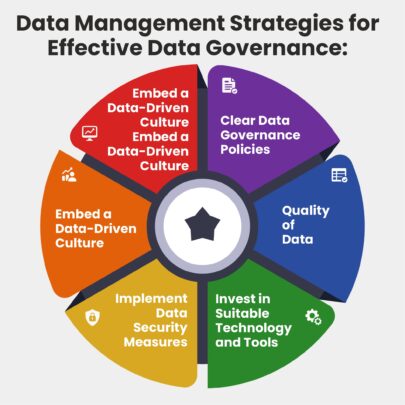Data is a fundamental asset for most businesses, and effective data management strategies are important for using this asset. Digital technology enables companies to collect a lot of information every day. This includes customer details, transaction data, and operational insights. Data provides businesses with a solid foundation for making informed decisions and improving efficiency and growth. However, managing this amount of data is a big task. It requires careful planning and organization. And that is when data management and governance come into action.
Data management refers to the process through which businesses collect, store, use, and secure data. Similarly, data governance is a concept that emphasizes ensuring the data is accurate, consistent, and used appropriately. Effective data management and governance help unlock the full potential of data within a business. In this article, we shall explore best practices in effective data management and good data governance.
Understanding the Importance of Data Management and Governance
Implementing effective data management strategies helps businesses avoid inconsistent data and poor decision-making. Before getting into data management strategies, it is necessary to understand why data management and data governance are important. Data management helps businesses to store, process, and use data in an organized manner. There is a chance that businesses may struggle with inconsistent data, poor decision-making, and missed opportunities without proper management.
According to sources, while all organizations see the importance of improving data analysis, about 36% have difficulty using their data fully because of management issues.
Data governance gives the assurance that data is used ethically and in a legal manner. It enables companies to ensure the quality, security, and integrity of their data. Without proper governance, the business may be subjected to lawsuits, leakages, and deterioration of reputation.
According to a 2024 report, around 60% of corporate leaders have made data governance a priority, highlighting its importance for Chief Data Officers (CDOs) and data security professionals.
The best where data is well-managed and governed:
- It facilitates good quality decisions because data are accurate and reliable
- Improves efficiency through lessened errors and streamlined processes
- Compliance with the laws and regulations of data
- Customer trust in terms of data safety and privacy
Data Management Strategies for Effective Data Governance:
1. Clear Data Governance Policies
Establishing clear data management strategies is essential for effective data governance. Data governance policies describe how data is to be managed, who should manage it, and what rules and guidelines are to be followed. It ensures that every individual in an organization is in agreement about how data is managed and used.
A good data governance policy will answer these questions:
- Data Ownership: It defines who owns the data and who should take care of it. In most businesses, the data owner is often a senior leader, but each department would have its own data steward responsible for maintaining the quality of the data.
- Data Classification: Classify data into categories based on its relevance, sensitivity, and usage. This classifies sensitive data to be safe and accessed only by authorized persons.
- Data Access and Permissions: Decide who gets to see what kind of data and set access permission rules. Limiting access prevents unauthorized access to the data.
- Data Retention and Disposal: Decide for how long the data will be kept and how it is going to be disposed of once it is no longer needed. Proper disposal of data is also important in avoiding accidental or intentional exposure of confidential information.
These policies must be disseminated clearly in the organization to ensure that people know what to do and are responsible for and concerning data management.
2. Quality of Data
One of the major challenges that the organizations face regarding data is keeping the quality. Maintaining data quality is a key component of successful data management strategies. Inferior quality of data can make wrong decisions that may waste resources as well as forgo opportunities. Processes must be established to make sure that the data is right, consistent, and complete.
Here are some best practices to maintain data quality:
- Data Cleaning: Clean the data regularly to remove duplicates, correct errors, and update outdated information. This can be done using automated tools or manual processes depending on the size of the dataset.
- Standardization: The data should be standardized on how it should appear. For example, all the customer phone numbers should be the same format, or all the addresses should be standardized. Formatting in a standard way is easier to analyze and work with.
- Data Validation: The rules should be implemented so that the data will be checked and verified for accuracy and completion before entering the system. For instance, you may require that emails be entered in the proper format or that no necessary fields are left blank.
- Data Profiling: Review and analyze your data regularly to identify patterns or problem areas that may have led to poor quality data. Data profiling tools aid in analyzing trends and points to further develop. Businesses that use quality data can avoid making money-losing mistakes and may make better decisions based on sound facts.
3. Invest in Suitable Technology and Tools
Managing data can be very complicated, especially when businesses grow and the volume of data increases. Fortunately, there are many tools and technologies available to help businesses manage their data more effectively. These tools can automate tasks, improve data accuracy, and make data more accessible to the right people.
Some of the key tools that can help businesses with data management include:
- Data Management Platforms: Data management platforms are used to assist firms in collecting, storing, and analyzing data in a system. DMPs can manage a large volume of data and integrate data across various sources.
- Customer Relationship Management (CRM) System: A CRM system is actually a form of storage as well as managing customer data that helps firms maintain a history of their customer's behavior, preference, and many more interactions.
- Data Warehouses: This is the integration of different large amounts of structured and unstructured data in one central repository by which businesses will store it there for easier analytical aggregation.
- Data Governance Tools: They help business to implement, monitor, or observe data use with regard to adherence to governing rules and laws; they have a feature which will automate jobs, such as access control, data classification, or data retention.
In choosing the appropriate tools, cost, ease, scalability, and integration with currently used systems do count.
4. Implement Data Security Measures
Data Security is one of the topmost concerns of data governance as businesses have to ensure the protection of their data from access, theft or misuse by anyone. Data breaches lead to legal issues, a loss in customer trust, and financial issues.
Here are a few best practices to ensure data security:
- Encryption: Encrypt sensitive data both in transit (when it's being sent across networks) and at rest (when it's stored on servers). This way, even if data is intercepted, it cannot be read by unauthorized people.
- Access Control: Use strong authentication methods to control who can access data. Implement role-based access control (RBAC) to restrict access based on the user's role in the organization.
- Regular Audits: Regular security audits help in detection of any weakness in the use of data security. This requires reviewing access logs, running vulnerability scans, and observing whether the policies of your security are being followed.
- Masking Data: Sensitive information should be masked if it will be used for testing purposes or development. It helps to exclude employees or third-party contractors' access to real customer data.
Businesses should further train their employees in some best practices in data security, when using strong and unique passwords, not falling for phishing, or following security procedures at all times.
5. Embed a Data-Driven Culture
To be fully effective, successful data management and governance will involve enabling an organization to create and support a data-driven culture within your organization. This means that workers at every level are encouraged to draw on data to make strategic decisions, and data is readable and accessible to everyone.
Some ways of encouraging this kind of culture are:
- Training and Education: Training employees so that they learn the importance of data and how to make use of it effectively. This includes the analysis of data, interpretation of reports, and data-driven decisions.
- Encourage Collaboration: Different departments should work together and share data. When departments collaborate with each other, they can find better insights and make more informed decisions.
- Set Data-Driven Goals: Set clear, measurable goals based on data. For instance, companies monitor levels of customer satisfaction or check on how their marketing campaigns are really performing using data analytics.
A data-driven culture encourages individuals to regard data as an asset and ensures that data management best practices are adhered to in all sectors.
6. Monitor and Continuously Improve Data Management Practices
Data management and governance cannot be a one-time affair. It is an ongoing process requiring constant attention and improvement. As business grows and new technologies arise, data management strategies must adapt to meet new challenges.
In this regard, businesses should continually strive for improvement by:
- Regular Review of Data Management Practice: To keep it current, review data management and governance policies periodically to see whether it is still applicable and is working. Update the policy or policies for change within the business or due to updates in regulations.
- Monitoring Usage: Monitor how the data is utilized across the organization and what may improve. That can be as simple as looking for data silos or ensuring that the data usage is conducted responsibly.
- Invest in Training and Development: Employees need to be trained to stay current with the trends and technology of data management. Train them to use new tools and practices that could better manage data.
Key Takeaways for Better Data Management!
Effective data management and governance are important for enterprises that are seeking to get maximum benefits out of their data. It, therefore, opens the business up fully to be utilized by such policies, the right investment in the appropriate tools, and prioritization of security. Better decision-making, increased efficiency, and customer trust will be a product of having good data governance frameworks. It does not come overnight but is brought about through constant attention, improvement, and a commitment to the responsible use of data. By following these best practices, businesses will ensure that their data is a valuable asset for years to come.
To get such valuable information visit us at WisdomPlexus!
FAQ
Q: What are data management strategies?
Ans: Data management strategies are the tactics organizations adopt for gathering, storage, and accessing data effectively. Data management aims to make the data collected more accurate, safe, and available for easy use.
Q: What is data management in data governance?
Ans: Data management within data governance defines how data handling can be correctly conducted through various rules and procedures that uphold quality data privacy, adhering to relevant legislation.
Q: What is data strategy and governance?
Ans: Data strategy is how an organization intends to use data to achieve the desired goals. Governance ensures proper management of data by having well-defined policies and responsibilities for use and protection.
Also Read:
Unlocking the Power of Data Accessibility in Business
Data Security: Top Tools in 2024 to Protect Your Business





